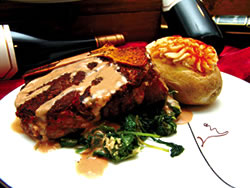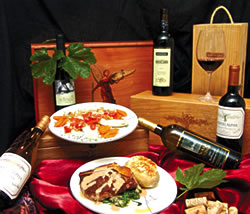YOUR HOME - INTERIOR LOOKS
Food and Wine Pairing 101
Entertaining the Question
October, 2005 - Issue #12
 Steak au Poivre |
It's harvest season, but the only wine pairing I'm familiar with is Ernst and Gallo. Help!
When paring food and wine, strive for balance and synchronization. Wine shouldn't overpower your food and vice versa. Wine reacts with food similarly to they way that a spice does. Successful food and wine pairing is accomplished when both similarities and/or contrasts of flavor, body or texture, intensity, and taste are met.
If you are serving more than one wine at a meal, it is customary to start with a lighter wine and move on to the fuller-bodied wines. Dry wines are generally served before sweet wines and lower alcohol wines should be served before higher alcohol wines.
Balance the flavor intensity by pairing light-bodied wines with lighter food and fuller-bodied wines with heartier, more flavorful, richer and fattier dishes.
Also consider how the particular dish is prepared. Poached and steamed food, delicately flavored, are paired best with a delicate wine. When braising, grilling, roasting or sauteing, the wine can be paired with the sauce, the seasoning or the dominant flavor of the dish.
Balance your sweetness. Generally, don't pair a wine with food that is sweeter. Sometimes opposites attract nicely. Very spicy foods work well with sweeter wines.
 |
A wine with little sweetness is considered dry. The sweet white wines are the Chenin Blanc, many Reislings and Spumante. Sweet red wines include the Lambrusco and Port.
When you have a menu item that is acidic, like one featuring citrus or vinegar, chose an acidic wine such as Sauvignon Blanc and most sparkling wines. The acidity in a wine will also cut saltiness, making sparkling wines pair well with salty food (i.e. champagne and caviar).
The skin and stems of grapes have tannins, which cause the bitter or astringent aftertaste in some red wines. Tannins mellow with age. Foods that are prominently salty, sour or bitter will make a wine seem less tannic and sweeter. Cabernet Sauvignon, Merlot, Zinfandel and Syrahs are wines in this category.
Steak au Poivre - 6 filet mignon steaks, 6 oz each
4 Tbsp green peppercorns in brine, well drained
4 Tbsp unsalted butter
1/2 cup cognac or brandy
1 cup beef or veal stock
1 cup heavy or whipping cream
1 Tbsp lemon juice
salt and pepper to taste
Pound meat to slightly flatten. Use two tablespoons of the green peppercorns and press into each side of the steaks.
Melt butter in heavy skillet and saute steaks over medium-high heat until brown on the outside but red and juicy on the inside, three to four minutes per side.
Pour off fat from skillet and add cognac or brandy. Flambe the steaks until flames are extinguished. Transfer steak to a platter and keep warm.
Add the stock, cream and remaining peppercorns to the skillet. Cook over high heat until thickened enough to coat the back of a spoon, seven to nine minutes. Season with lemon juice, salt and pepper. Spoon sauce over steaks and serve immediately.
This recipe serves six. We suggest Twice Baked Potatoes or Sauteed Garlic Spinach for accompaniments. Wine suggestions include a full-bodied Pinot Noir, Zinfandel or Syrah. Choose a wine that has black pepper tones.
--------------------------------------------------------------
Cindy and Tamra are owners of RSVP Catering.
|
||||||||||||||||||||||||||||




